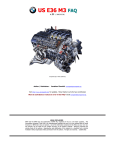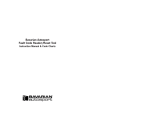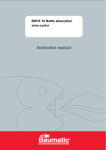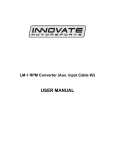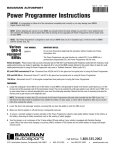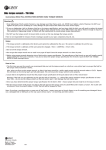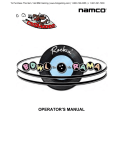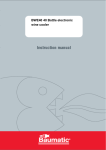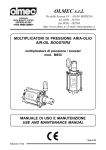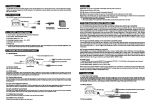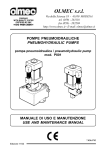Download BMW newsletter - Bavarian Autosport
Transcript
the newsletter of Bavarian Autosport spring 2006 Sachs Performance sets receive top rating in European car magazine comparison test! C-Tech pads really bite! Not long ago, Germany’s Gute Fahrt magazine conducted a head-to-head comparison of suspensions kits, including the Sachs Performance kit, Eibach springs/sway bars, Bilstein PSS9 (adjustable coil-over), KW Version 3 and the factory sport suspension on an Audi A4. The driving test consisted of two segments: 3,000 kilometers (1,860 miles) of everyday driving, followed by varying loads and conditions on the test tracks of the Contidrom. Mintex C-Tech pads are made by TMD Friction, the world’s largest friction manufacturer and OE (original equipment) supplier to many vehicle manufacturers in Europe, Asia and North America. Mintex pads are used extensively by NASCAR, CART and Late Model Racing Teams in the USA, as well as by FIA GT, International Race and Rally Teams in Europe. In the first test (everyday driving), the Sachs suspension was rated best for comfort and noise. On the test track, Sachs rated highest for dry handling and tied for highest in wet handling. Here’s what the editors had to say about the Sachs kit: “Handling: Even less swaying and nodding inclination than the [factory sport setup]. Good steering precision, with a fine and well controllable dynamic triggering of the rear end, the [vehicle] reacts quite sensitively to load shifts.” “Wet-weather handling: The convincing balance of the Sachs chassis manifests itself positively on the wet-weather handling course... exemplary traction ensures top values for the lap times.” Sachs Performance sets include four, perfectly matched, twin-tube shocks and sport springs. “Comfort: The spring rates are comparable to the factory sport suspension, but with earlier progression, so the rebound at the front axle is softer, not harsh.” “The bottom line is that the Sachs Performance Kit provides a perfect, comfort-oriented all-around [setup]... this made the Sachs kit worth a ‘very good’ to us – the only such grade in the test.” (The others were rated as ‘good’ or ‘satisfactory.’) Race technology = better handling. Sachs' involvement in, and commitment to, Formula 1 and many other race series has allowed them to develop high performance kits for the road. Sachs Performance sets are manufactured for active drivers who have an increased need for performance without sacrificing comfort. The kits feature twintube, gas pressure shocks that are perfectly matched with progressive-rate lowering springs at all four corners. This combination provides not only the good looks of a lowered BMW (between 30-40mm, depending on the BMW chassis), but a noticeable improvement in cornering and handling. And each set has been engineered to suit the weight and handling characteristics of a specific BMW model. When we asked the engineers at Sachs to elaborate on this, we received a technical brief that included several paragraphs such as the following: “A modified spring rate and even a different construction length may be necessary when lowering the chassis in order to reach homogeneity between all components... On the shock absorbers, continued on page 2... phone 800.535.2002 • Mintex makes three different compounds for their C-Tech pads: two are for racing only. The M1144 compound continued on page 2... times table of contents Sachs Performance suspension 1 Mintex C-Tech brake pads 1 Ultimate car cover: 7 reasons why 2 Ask Bavarian Otto 3 Bavarian Profile: Bob Weeks 3 D.I.Y.: Preventive maintenance 4-7 D.I.Y.: Transmission fluid change 7 April specials 8 © 2006 Bavarian Autosport fax 800.507.2002 • www.BavAuto.com Bavarian Autosport 275 Constitution Ave. Portsmouth, NH 03801 PRSRT STD U.S. POSTAGE PAID BAVARIAN AUTOSPORT Sachs Performance sets C-Tech brake pads continued from page 1 continued from page 1 rebound length and housing length are especially taken into consideration and adjusted as needed in order to guarantee initial spring tension and meet the legally-required rest range of springs in unfavorable circumstances.” we offer is made specifically for performance street driving and track days. M1144 is a low-metallic, resin-bonded material using steel and acrylic fibers. This stateof-the-art material offers: After reading the entire brief, our heads were spinning with all the information. But the one thing we could tell you with absolute certainty is that these engineers are incredibly serious about the technology behind their shocks and springs. (Would race teams like Scuderia Ferrari and car manufacturers like BMW work with them if they weren’t?!) • Great value – even better on sale. Even at full price, Sachs Performance sets represent a phenomenal value, costing less than just about any other performance shock/lowering spring setup we offer. And now during April, they’re an even better value at 10% off; orig. $679.95–1399.95, now just $611.95–1259.95. Don’t delay – sale ends April 30, 2006. Boge is now... er, has always been... Sachs! You may have noticed in our catalog and on our web site that Boge shocks are now called Sachs. Boge and Sachs are owned by the same company. For over 100 years, car manufacturers have entrusted their vehicle ride quality to Sachs and Boge engineers, as has BMW on nearly every single model for decades. For the past five years, only the Sachs brand of shocks has been sold to vehicle manufacturers, while both brands were used in the aftermarket. Now, to further reinforce the OE lineage, the company has decided to distribute only under the Sachs brand. So, by official decree, Boge shocks shall hereby be known as Sachs shocks. (Unofficially, if you still ask for Boge shocks, we'll know what you mean. You'll get the same great quality shocks, it'll just say Sachs on the box they come in.). High friction across a wide range of temperatures. • Excellent cold friction (no “dead feel” when you first apply the brakes), making it suitable for both street and track use. (No need to change pads when you go from the street to the track, and back.) • Low dust – no asbestos. • Operates up to 450° C (840° F) without significant fading. If you’re into spirited driving and your brakes could use new pads, we highly recommend C-Tech. In fact, we like C-Tech pads so much that, whenever possible, we use them in our new street performance brake kit. (See page 25 of our new Spring & Summer catalog or visit www.BavAuto.com.) Need an incentive to try C-Tech pads? Now thru April 30 we’ll take an additional 10% off all C-Tech prices: originally $84.95–169.95, now $76.45–152.95. P.S. While you’ve got the wheels off the ground, why not change your rotors, too? Our Ultimate brake rotors are also 10% off, but only until April 30. 7 reasons why our Ultimate car cover is a great value: We think our Ultimate car cover is the best value in a BMW car cover anywhere. Granted, we’re biased, (after all, we did give birth to this baby), so we thought we’d try to support our claim with a few facts: 1. Lighter in weight. Our Ultimate cover is made from a technologically advanced, lightweight, woven fabric. You don’t need to be a weightlifter to it put on or take it off. (Plus it doesn’t absorb water like perforated covers.) 2. Packs smaller. Because we use a woven fabric, our cover isn’t as bulky, so you can easily stuff it in the free storage bag, toss it in the trunk and still have room for groceries, sport equipment, etc. Other, bulkier covers take much more effort to bag, and they seem to take up the entire trunk. 3. Custom-tailored. Every pattern has been fitted and re-fitted until we’re happy with it. The picture at right shows a stock 330ci wearing an Ultimate car cover we grabbed off the shelf in our warehouse, (not some one-off version that was created just for the photo shoot). 4. Detachable, adjustable wind straps. Most of the time you won’t need them, but when the wind kicks up, they do come in handy! And no other cover has them. 5. FREE cable lock kit. Steel aircraft cable (vinyl-coated so it won’t scratch your BMW’s paint) and a keyed padlock help deter theft and vandalism. A $10 value. Left: Our Ultimate cover stores small – about the size of a 12-pack of soda – so you can easily keep it in your trunk. 6. Lifetime Warranty. (Other car cover warranties range from 90 days to 4 years.) Right: We invented these cinch straps to keep our Ultimate car cover in place in high winds. They’re easy to use – just clip them on and pull them taut. Protective pockets keep the clips away from your BMW’s paint. 7. They’re on sale throughout the month of April. Originally $174.95 (smaller BMWs), $179.95 (most BMWs) and $209.95 (X5), they’re now $20 off at $154.45, $159.95 and $189.95 respectively. Sale ends April 30th. 2 | shop online www.BavAuto.com Very simple installation. Relatively simple; your BMW may need to be raised. from our tech team ask “bavarian otto” If you add up all the years the enthusiasts at Bavarian Autosport have been working on BMWs – and helping people like you work on theirs – it totals well over 200 years. That’s a lot of BMW knowledge. And it’s yours for the asking. Have a BMW question? Ask that savvy old BMW enthusiast, “Bavarian Otto” – just call 800.535.2002 or e-mail [email protected]. To supercharge or not to supercharge; that is the question... Dear Bavarian Otto, I want to get more power out of my 93 325is. I’m looking at your supercharger kit but am turned off by the fact that everyone keeps telling me this could seriously shorten my engine life. I thought about a stroker kit (if one is available), having the head ported and polished, and maybe some other bolt on modifications that you might recommend. Would you please point me in the right direction? Thank you very much. Vinai Otto replies: Well, everyone seems to be an expert on every subject these days, especially on the internet. (I wonder how many of those who are trash-talking the supercharger have actually been involved with installing, tuning and running them... and which systems they have experience with?) As far as engine life and making more power are concerned, a properly set-up supercharger will not affect engine life any differently than naturally aspirated modifications that make the same power. In fact, for a daily driver, you would be better off with a supercharger than all of the mods you mentioned. In a supercharged application, you are not taxing the engine during regular, everyday driving. But with the big-bore, long-stroke, big-port, bigvalve, big-cam, etc., etc., you are running the engine in a high-strung manner all the time. Another point to consider: there is no way you'll make as much power on a BMW with all those mods as you would with the supercharger. Getting anywhere close to 250hp at the rear wheels by performing the mods that you noted – without the use of a supercharger – would produce an engine that has no torque at low and mid RPM. (No fun on the street.) A supercharger increases power across the full RPM range. The Active Autowerke supercharger kits we offer make great power. On your 325is, you’d gain roughly 90hp and 61lbft of torque at the rear wheels. On top of that, these kits are very reliable and relatively mild (just 8lb of boost) in how they interact with your engine. In other words, as long as you're not at redline all the time, engine life is really not an issue. To tune or not to tune; that is the question... Dear Bavarian Otto, Would it be easier and cheaper for me to take my 318ti to a shop to get a tune up, or for me to do it myself? The thing is, I don't really trust anybody with my car. I just got it two months ago and it’s time to do an oil change. What tools do I need to perform a tune up? Can any mechanic do an oil change on a BMW? Do I need to buy some kind of book from you guys to help me do it? I would greatly appreciate your advice. Thanks. Sergio Specific tools needed; repair experience recommended. Too cheap or not too cheap; that is the question... Dear Bavarian Otto We have a 97 528i with 51,425 miles. Last weekend, it overheated. I found a crack on the thermostat housing, so I bought one and was told I might as well replace the thermostat while I’m at it. So I did. My problem is that the temperature gauge goes way up to the red part. Is that because I used offthe-shelf coolant instead of BMW coolant? What could be causing this? Erlinda Otto replies: Using cheap coolant will not cause your engine to run hot. (There are, however, other issues to consider such as accelerated corrosion inside your radiator. Both the BMW coolant and Evans NPG+ provide excellent protection against corrosion damage – better than those off-the-shelf brands,) No, I would assume that either there is still air in the cooling system that needs to be bled out or that the thermostat is faulty. If the shop installed the thermostat, they should be responsible for figuring out why it is now running too hot after the replacement. If you did the installation, I would recommend bleeding the system again and letting me know what happens. Dear Bavarian Otto, Thank you so much for your response. You were right – the system just needed to be bled. There is a Bimmer god and his name is Otto! Erlinda Bavarian Profile Over 200 years of BMW experience is just a phone call or e-mail away. Otto replies: It would definitely be cheaper for you to do the tune-up yourself. I recommend that you purchase a Bentley service manual for your 318ti. For a simple tune-up, the only tools you should need would be a basic metric socket set (available at any hardware store), one of our special wrenches for the oil filter cap, and our reset tool for the oil service lights. (Your 318ti should have a spark plug wrench in the tool kit in the rear of the car. If it’s missing, we can get you a replacement.) Once you have a manual and the tools (about $150 if you’re starting from scratch), each subsequent time you do a basic tune-up, you’d only need the “consumable” parts – oil filter, air filter, fuel filter, cabin microfilter, spark plugs and engine oil (we recommend BMW-approved Lubro-Moly oil), which will run you about $140. You’ll save hundreds and be providing better care for your beloved Bimmer. [Ed. Note: Costs will vary depending on year and model BMW. See related article on Preventive Maintenance on pages 4-5.] Bob Weeks Bob became a Bavarian Autosport employee in September of 1997. For the first five years of his tenure here, he worked in sales – both as a phone rep and in the showroom – helping BMW enthusiasts figure out what parts they needed for their Bimmers. Three years ago, his friendly, patient and thorough manner in dealing with customers earned him an invitation to join the Customer Service team. He now spends the majority of his time assisting Bavarian Autosport customers who have questions about product usage, installation, order changes, etc. Bob has owned a 1984 318i (in which he put a 325i motor and drive train) as well as two different 1976 2002s. His interests outside work include motorcycles (he hopes to make a bike his next purchase), hiking, fishing and hunting. Bob must like his job very much – he commutes to Portsmouth from his home in Enfield, NH, more than 100 miles away. (No wonder he wants a bike!) Experienced technicians only. call 800.535.2002 | 3 How easy is this?! do-it-yourself Preventive Maintenance: Save money, avoid repairs, improve performance & resale value. u•to•pi•a (noun); an imagined place or state of things in which everything is perfect. Lifetime fluids… 100,000-mile spark plugs… 15,000mile oil changes… sounds like Utopia to us! And that's the impression auto manufacturers would like us to have when it comes to the vehicles they sell. For decades, BMW has made every effort to provide the utopian experience behind the wheel – in quality, comfort and driving experience. These days, there’s another aspect that car manufacturers (BMW included) are attempting to portray as utopic – cost-of-ownership; more specifically, preventive maintenance (PM). PM is regular servicing done to keep the vehicle in top shape. BMW calls this “Scheduled Maintenance.” The road to Utopia... or a one-way ticket to premature repairs?! In the past, much of the cost-of-ownership figure could be attributed to PM. Therefore, if PM costs can be reduced, the overall cost-of-ownership (at least during the first few years) will go down and the vehicle will be rated higher by consumer groups and look more appealing to prospective buyers. Some vehicle manufacturers have taken this “reduced PM” to extremes. We now see service schedules which, except for an oil change or two, eliminate nearly all PM until after the warranty period has expired. To make this plausible, manufacturers have begun using so-called 100,000-mile spark plugs, lifetime transmission and differential fluids, and engine oil that doesn’t get dirty for 15,000 miles. (Would you like to try one of our 24-hour diapers, madam?) Plus, there is no mention of any other fluid changes at all! This is fine for the manufacturer, who is trying to lower the cost-of-ownership, but it does nothing for the vehicle owner who wishes to keep his/her BMW for longer than a couple of years, not to mention the next owner of this pre-owned BMW. To keep your BMW in top condition – today, tomorrow and for years to come – you need to set-up and follow a realistic PM program. This will assure not only fewer unscheduled repairs, but a higher resale value. Follow along as we take a look at a well-thought-out PM program for your BMW. NOTE: all the PM intervals that we recommend in this article are based on typical vehicle use (e.g. daily driving for 15,000 miles per year). If you drive your BMW in an aggressive manner, in poor or dusty conditions or at drivers’ schools or autocross events, you should reduce the PM intervals. Engine Oil: We highly recommend the use of a “top shelf” synthetic motor oil such as Lubro Moly and Red Line. These oils are “slipperier” than standard petroleum oil, so they significantly reduce the amount of wear on internal engine parts, as well as provide better fuel economy and higher power output. The reduced wear and lower friction results in a direct savings for you; you’ll spend less on fuel and will have much less likelihood of costly repairs due to engine wear. (The increase in power output is a bonus!) Left: Dipstick with clean oil. Right: Dirty oil. When synthetic oil is used in an engine that is in good shape to begin with (i.e. does not significantly burn oil), we recommend a change interval of 5,000 to 7,000 miles. At this point, typically, the oil is still in usable condition, molecularly. However, foreign particles and contaminants from the engine’s combustion process will have built up to a point that they should be flushed 4 | shop online www.bavauto.com from the engine. A good rule of thumb is to change your oil when its appearance changes from translucent (you can see through the oil to the dipstick) to opaque (you cannot see through it). As the oil ages, it will become darker yet will still be translucent. Once you can no longer see through the oil, it’s time for a change. Keep in mind; this interval is valid for “top-shelf” synthetic oils only; a petroleumbased oil should be changed every 3,000 miles or so. When the oil is changed, the filter should also be changed. Never run a used filter with fresh oil! After much research, we have found that the Mann oil filters are the best filters for most of the BMW models. We have dissected many well-known oil filters and have been appalled at what we’ve seen. Now that we know what’s behind that pretty face – and high-dollar advertising campaign – we appreciate even more the precision manufacturing of The basics: synthetic oils, Mann filters, filter wrenches, reset tool, drain pan and gloves. Mann filters. Ignition System: or Remember the days of changing spark plugs once or twice a year... and adjusting and changing ignition points even more often? Well, things have changed. Today’s engine management systems are miracles of electronic manipulation: engines that generate 400 hp are displaying fuel mileage figures that a 1975 2002 would have been proud to produce. We also benefit from a greatly reduced need for PM in the ignition system. However, “greatly reduced” does not mean “maintenance-free.” There are still spark plugs to change, ignition wires to replace (or the equivalent connector boots in coil-onplug applications), cap and rotor (on the older BMWs) and coils. Spark Plugs – BMW, along with the other manufacturers, is recommending spark plug replacement at intervals as long as 100,000 miles. As mentioned earlier, today’s generation of ignition parts, including spark plugs, are far better than yesteryear’s pieces. However, 100,000 miles on a spark plug is just a bit excessive. At this long interval, the plugs are past the point at which they have begun to degrade in performance. We have two different recommendations for the early and Bosch Super with 10,000 on it. late generations of BMWs: • Early models that use the standard Bosch Copper, Silver and Super single-electrode plugs should follow a 30,000-mile replacement schedule for continued peak performance, (more frequently if the engine burns oil). • The Bosch dual- and quad-tip plugs used in later models can typically run from 30,000 to 60,000 miles before starting to show a degradation in performance, assuming there is no oil burning and the rest of the system is running properly. Spark plug wires and connectors – As with the spark plugs, there are generally two generations of ignition wires or connectors for our BMWs. Early models that have distributor caps and a single ignition coil use full ignition wire sets, running from the distributor cap to each spark plug. (Note that 4-cylinder models 1990 on have 4 coils with a wire running from each coil to each plug.) Later BMW V8s and 6-cylinder cars have a separate ignition coil for each spark plug, and the coil is mounted directly on top of the spark plug via a short connector boot. Ignition wires, cap, rotor, spark plugs and connector boots. Very simple installation. Relatively simple; your BMW may need to be raised. Radiator drain plug Brake fluid Oil filler cap Power steering fluid & filter Oil filter Spark plugs & connector boots (under trim cover) Oil dip stick Air filter Engine oil drain plug Transmission drain plug Preventive maintenance service points underneath a 3 series 99 thru 05. Radiator cap Preventive maintenance service points under the hood of a 3 series 99 thru 05. We recommend that stock ignition wires be replaced at 50,000 to 100,000 miles, depending on environmental conditions and actual calendar time. (Due to high quality materials and construction, our high-performance ignition wires come with a lifetime warranty and should never need to be replaced… a nice upgrade for just $20.) The connector boots used on later models must also be replaced. (See the Spring 2005 Fast Times at www.BavAuto.com/newsletter.) They will eventually deteriorate and allow the spark to arc to the walls of the plug wells. We have found that these connector boots start to show degradation at around 60,000 to 100,000 miles. We recommend replacement with the spark plugs. (Tip: Since you have to remove the ignition coils to change the spark plugs and connector boots, you should consider upgrading to our high-performance ignition coils. They provide increases in horsepower, torque and fuel economy… plus they come with new connector boots.) Cap and Rotor – Earlier BMW models that have an ignition cap and rotor should use a replacement interval of 30,000 to 60,000 miles for these parts. Air Filters: We recommend replacement of standard, paper air filters once a year; more often if the vehicle is operated in dusty conditions. (A sixmonth inspection will help you gauge the replacement interval.) A dirty air filter will impede airflow to the engine, reducing performance and increasing gas consumption. Additionally, a dirty paper filter will eventually allow contaminants to pass through into the engine, greatly increasing engine wear and the Air filter replacement is a simple task. likelihood of future unscheduled maintenance. An alternative to the standard, paper filter is the cleanable/reusable filter such as K&N and AFE (see the Winter 2006 Fast Times). These filters typically offer superior filtration and an increase of airflow to the engine. This results in longer engine life due to less wear from contaminants as well as a lower operating cost due to modestly improved fuel economy. Choose between AFE, Mann and K&N air filters. Specific tools needed; repair experience recommended. Dif ferential ferential drain plug (fill plug on side) Additionally, the increased airflow will provide an increase in power. These filters are purchased once, then cleaned and recharged at regular intervals. Depending on how long you own your BMW, the lifetime cost of these reusable filters can be less than regular replacement of standard filters. You should also remember to change your cabin air microfilter(s) as the same time. While these filters do not affect the performance of your BMW, they affect your health and the way your Bimmer smells... or doesn’t! (See the Summer 2003 issue of Fast Times at www.BavAuto.com/newsletter.) Fuel Filter: We recommend an annual replacement of the fuel filter. This will assure long life for the fuel pump and fuel injectors. A partially clogged fuel filter will put a strain on the fuel pump and shorten the life of the pump. The engine’s performance can also be affected due to reduced fuel flow. Additionally, a partially clogged filter can rupture internally and release all of the contaminants it has captured into the fuel system. Mann fuel filters and Würth hose clamps. Transmission Fluid: Automatic transmissions – For some reason, BMW has been historically reluctant to prescribe what would be considered a standard fluid and filter change interval on their automatic transmissions. To make matters more extreme, fluid and filter changes aren’t even prescribed for later BMW models (mid-90s to current). BMW went so far as to label their fluids and filters “lifetime.” We have never agreed with this, believing it was simply another cost-ofownership measure. The fluid in an automatic transmission is the life-blood of the transmission, functioning as a lubricant, a coolant, a detergent, a clutch and the functional controller of the transmission’s operation. Clean fluid is absolutely critical to the life of the transmission. Historically, the reliability of BMW automatic transmissions has been Transmission fluids, filters, drain pan and gloves. sketchy above 100,000 miles. When we come across non-functional automatic transmissions, we usually find that the fluid and filter were not changed at regular intervals. (By the way, BMW recently dropped the “lifetime” moniker from their fluids and filters and replaced it with “extended service.”) At a minimum, we recommend changing automatic transmission fluid and filters semiannually (every other year) or at 50,000 miles. (An annual fluid change would certainly do no harm.) This is the best and most cost-effective way to assure a long, trouble-free life for your BMW’s automatic transmission. Earlier BMWs with automatic transmissions use Dexron III fluid; later BMWs use one of three different “lifetime” fluids. You must use the proper fluid for your application. Bavarian Autosport carries all of the proper fluids and the filters. (See related D.I.Y. on page 7.) continued on page 6... Experienced technicians only. call 800.535.2002 | 5 How easy is this?! do-it-yourself Brake Fluid: continued from page 5... Manual transmissions – BMW’s PM schedule for manual transmission fluid replacement is also less than optimal for achieving a long, trouble-free life. As with the automatic transmissions, BMW has used a few different fluids over the generations. Earlier BMWs with manual transmissions use either a standard 80w GL-4 gear oil or Dexron III automatic transmission fluid. Later BMWs use the infamous Fill “lifetime” fluid. For all BMW manual plug Drain plug transmission applications, we highly recommend fluid changes annually or every 24,000 miles. If the transmission has any leaks, the fluid level should be checked every 6 months and adjusted as required. A low transmission fluid level will quickly produce worn and damaged bearings, synchronizers and shift forks… all result- Manual transmission on a 1999 323i. Fill plug and drain plug are indicated with arrows. ing in an expensive repair bill. For the early BMW applications, we use and recommend Redline MTL. This synthetic fluid is lighter in viscosity than the 80w gear oil and offers better wear protection and reduced frictional losses. The result is longer life and more power being transmitted to the rear wheels. Additionally, Redline MTL contains special additives that assist the shift synchronizers in working properly. (Other synthetic fluids do not incorporate these modifiers and can actually make the shifting more difficult due to the synchronizers slipping.) For later model BMWs that use the “lifetime” synthetic fluid, we offer this BMW replacement fluid. Fluid, drain plug tool, drain pan and gloves. NOTE: Many of our customers are using Redline MTL fluid as a replacement for their “lifetime” manual transmission fluid, with no apparent problems. However, until we see more history of MTL use in these applications, we are not prepared to make an official recommendation. Power Steering Fluid: This is what we would consider the most overlooked PM item on most BMWs. (Think about it – when was the last time you ever changed the power steering fluid… on any vehicle?) On BMWs, this system provides the boost for not just the steering, but often for the power brakes and the operation of the self-leveling suspension, as well. Time and time again, we’ll look at the power steering fluid in a BMW and it is filthy! (Running on old, degraded fluid will shorten the useful life of the steering rack/gearbox, brake booster, fluid pump, etc.) The fluid should be bright, clear red or, depending on the application, just clean and clear. One of the reasons this system gets overlooked is that there is no direct provision for changing the fluid, therefore the job is a bit more tedious. Old fluid (left) vs. fresh fluid. But it is not so tedious that it should be ignored. We recommend a semi-annual (every other year) or 50,000-mile fluid change for the power boost system. Additionally, the system does have a fluid filter incorporated into the fluid reservoir. (A lot of mechanics do not even know that this filter exists!) Change the filter when changing the fluid. There are three different fluids used in the power boost systems on BMWs. Bavarian Autosport offers all three fluids and we can assist in determining the proper fluid for your BMW. 6 | shop online www.BavAuto.com Here we have the second-most overlooked PM operation – the periodic flushing and replacement of the brake fluid. Most failures of brake system components can be traced to the effects of water in the brake fluid. The most common failure is due to corrosion of the metal cylinder bores and pistons in the calipers and cylinders. The problem of water in the system is exasperated by the fact that brake fluid is hygroscopic; in other words, the fluid attracts moisture from the atmosphere. This moisture will eventually build up in the brake fluid and begin to corrode the metal parts and degrade the rubber hoses. Old, dirty brake fluid inside a brake fluid reservoir. The best defense against moisture-induced brake system failures is to flush and replace the brake fluid at reasonable intervals. For our BMWs, we recommend an annual brake fluid flush. In this instance, we are more concerned with the actual time frame than the mileage. The flush is performed in a similar manner as regular fluid bleeding (when removing air from the system), except that we bleed enough fluid from each caliper (and the clutch slave cylinder) to effectively remove all of the old fluid and replace it with fresh new fluid. (See Fall 2005 Fast Times at www.BavAuto.com/newsletter.) We recommend ATE Super or RGS610 high-performance, DOT-4 fluids. These fluids actually have a much higher operating temperature and are less Brake bleeder, receiving bottle, brake fluids, clutch bleeder and gloves. hygroscopic than most other DOT-4 fluids. Differential Fluid: Differential fluid is likely the third most overlooked fluid that must be changed at periodic intervals. A proper PM schedule for the differential fluid will assure that the differential lasts as long as the rest of the vehicle. fill The differential does not hold much fluid, thereplug fore we do not have much of a “cushion” if the fluid becomes overheated, broken down or contaminated. Regular fluid changes are, by far, the cheapest insurance against long-term problems. We recommend an interval of semidrain annual (every other year) or 40,000 to 50,000 plug miles as the maximum. (You certainly would not be doing a disservice to change the fluid annually or after 25,000 miles.) If the differential has any leaks, the fluid level should be checked Rear differential on a 3 series 99 thru 05. every 6 months and adjusted as required. A low fluid level will quickly produce worn/damaged bearings and gears, resulting in an expensive repair bill. Fluids, plug tool, drain pan and gloves. We recommend a full synthetic fluid for use in your BMW differential. Synthetic fluid will hold up better to the high stress of the differential gears, bearings and limited-slip applications than standard petroleum-based fluids. We offer both Redline and LubroMoly synthetic differential fluids for your BMW. Antifreeze/Coolant: BMW has been recommending anywhere from two to five years for coolant flush intervals and, depending on conditions, these periods are not totally out of line. However, as with our other PM areas, we prefer to be a bit more aggressive... with a long, problem free, service life as our goal. Power steering fluids, reservoir and filters. Very simple installation. Relatively simple; your BMW may need to be raised. How easy is this?! The anti-freeze/coolant mixture in our BMWs does far more than just keep the water in the engine, radiator, etc., from freezing. The mixture raises the boiling point of the coolant, increases the heat transfer by reducing localized hot spots in the engine, Radiator drain plug prevents corrosion of the iron, steel and aluminum parts and lubricates the water pump. All of these properties are handled by various compounds added to the original coolant product. With age, these additives break down and their abilities to transfer heat, fight corrosion and lubricate metal are reduced. This is the reason for periodic coolant flushes… even if the anti-freezing properties are still adequate. We recommend a semi-annual (every other year) to three-year coolant flush, in order to assure 100% protection against corrosion and oxidation damage to the cooling system. This is assuming that the BMW original coolant is being used. BMW coolant offers greater corrosion protection than standard coolant mixtures. Bavarian Autosport carries the BMW coolant, as well as NPG+ waterless coolant. This specialized coolant is used at 100% concentration (as opposed to the 50/50 mix for the BMW coolant) and therefore there is no water in the system. This fact, along Anti-freeze/coolant, drain pan and gloves. with the premium additive package, makes the NPG+ a very long-term coolant. In fact, when properly used, the NPG+ can be considered usable for the service life of the vehicle. do-it-yourself Automatic transmission fluid change. The automatic transmission is one of the most sensitive systems on our BMWs. As such, we believe it requires Preventive Maintenance (PM). During the 70s, 80s and early 90s, BMW basically ignored PM on their automatic transmissions. As a result, we have seen a history of transmission failures prior to what we consider to be an acceptable service life. Now BMW is touting “lifetime” fluids. We don’t buy it. (See our arguments under “Transmission Fluid” on page 5.) Come on along with us as we perform a fluid and filter change on a 2001 540i with a “lifetime” automatic transmission. (FYI: when we drained the transmission, the fluid that came out was filthy – with just 80,000 miles on it!) NOTE: For fluid type and fluid-level checking procedures, refer to the appropriate repair manual for your BMW. DO NOT use any fluid other than what is specified for your BMW’s transmission. If you have questions on what fluid to use, ask your Bavarian Autosport phone rep – we stock all of the applicable fluids. (See page 78 of our Spring & Summer catalog.) This BMW uses Esso LT 71141 type fluid. 1. Properly raise and support the vehicle. 2. Remove undercarriage splash guards, if applicable. 3. Put a drain pan under the transmission fluid pan. 4. Loosen fill plug. Remove drain plug from transmission fluid pan and drain fluid (figure 1). Figure Figure 1 5. Loosen and Belts & Hoses: Not much is more frustrating than being cut short on that great vacation road trip by a blown coolant hose or broken drive belt (water pump, alternator, etc.). Fortunately, this scenario is easy to avoid. Inspect all hoses annually and replace them at 4 years or 100,000 miles. Hose replacement should be planned to coincide with a coolant flush, as you’ll be draining coolant for either operation. Inspect the accessory drive belts and tensioner pulleys annually and replace at 4 years or 50,000 to 75,000 miles. Bavarian Autosport stocks all of your coolant hoses and accessory drive belts and tensioners. We carry all the BMW belts and hoses! remove securing bolts on the fluid pan and remove the pan and gasket (figure 2 & 3). 6. Remove filter and Figure Figure 2 filter to valve-body O-ring, if applicable (figure 4). Figure Figure 3 7. Clean fluid pan and debris magnet (figure 5). 8. Install the new filter and O-ring, if applicable. 9. Install the fluid pan with a new gasket. 10. Remove the fill plug and pump new fluid into An easy-to-follow, BMW PM schedule: Mileage 3,000 5,000–7,000 15,000–20,000 Service traditional petroleum oil; oil filter synthetic oil; oil filter air filter; cabin microfilter; fuel filter, brake fluid Figure Figure 4 (or annually) 30,000 30,000–50,000 (or semi-annually) 50,000 50,000–100,000 spark plugs (older style) spark plugs (newer style); cap & rotor; transmission fluid & filter; differential fluid power steering fluid ignition wires; spark plug connector boots Figure Figure 5 Specific tools needed; repair experience recommended. Experienced technicians only. the pan until it is level with the bottom of the fill plug hole. On older models with a fluid level dipstick, refill through the dipstick tube up to the “cold” level on the dipstick The final fluid level adjustment must be made with the transmission and fluid at regular operating temperature, (generally around 85 to 120 degrees Fahrenheit, or warm to your hand on the bottom of the pan). At this point, with the engine running and the shifter in park or neutral, the fluid should be to the FULL mark on the dipstick or up to the bottom of the fill plug hole. For more details on your BMW’s transmission, please refer to the appropriate repair manual for your year and model BMW. call 800.535.2002 | 7








